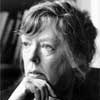| FEATURE | ||
|
|
Debra Allbery | |
|
|
"The Third Image": Constellations of Correspondence in Emily Dickinson, Joseph Cornell, and Charles Simic, an essay on ekphrastic poetry and the notion of poetry and painting as "the sister arts." | |
| Debra Allbery | ||
|
|
Three ekphrastic poems: "Courbet," "No Tutor but the North," and "How to Explain a Dead Hare." |
|
|
POETRY |
||
|
Betty Adcock Charles Coté Martyn Crucefix Burt Kimmelman Eric Pankey Michael Salcman Nicholas Samaras Jim Tilley Gloria Vando Eleanor Wilner |
||
Interview |
||
|
|
A Note on Fictional Truth, a Conversation with Ed Pavlić, by Andrew John McFadyen-Ketchum.
|
|
| Book Review | ||
|
|
"A Change of Maps" by Carolyne Wright—Book Review, by David Rigsbee.
|
|
Eleanor Wilner |
|||
 |
Eleanor Wilner is the author of six books of poems: The Girl with Bees in Her Hair (Copper Canyon, 2004), Reversing the Spell: New and Selected Poems (Copper Canyon 1998), Otherwise (U. of Chicago, 1993), Sarah's ChoiceU. of Chicago, 1990), Shekhinah (U. of Chicago, 1985), and >maya; a translation of Euripides' Medea (U. of Massachusetts, 1979); and a book on visionary imagination, Gathering the Winds (Johns Hopkins, 1975). Her work appears in many anthologies, including The Norton Anthology of Poetry 1996. She has taught at many colleges and universities, most recently at the University of Chicago, Smith College, and Northwestern University. | ||
An erotic intensity that demands something just as real and human in return. The relationship may be only with an image, yet it involves all that art is supposed to keep at bay. For an instant, I see her, before her face was clich�, where she hung, on the wall by the front door, at the foot of the staircase, in the little house of our childhood, and floated above us, a presence, always there, silent, by the Dutch-style door, whose top we swung open in summer. They have sullied The Girl with the Pearl Earring, subjected her to their prurient gaze—novelized, eroticized, reduced her to gossip and innuendo, backstoried her as servant, thorn in the side of a wife, object of desire, poverty's child, mute with class diffidence and awe, as if she could be aware of posterity's view of the painter—all this from a mysterious glow and unreadable expression, the illusion of being seen by her gaze, a shimmer of pearl, brush strokes of lapis lazuli, crushed to intensify blue. Overexposed, even in film, where they followed her to her family's dark hovel, to the wet stones of the market where she met the butcher's son she would marry for meat—my god, couldn't they leave her alone, in the nether region of art where she is, so beautifully, no one—not servant, or mistress, or his daughter Maria, but anonymous, secret, what no one can name, pure mystery of being, restored across time by art, which keeps nothing at bay.
|
||
| © 2008 The Cortland Review |
[ HOME |
About |
Audio |
Authors |
Bookstore |
Multimedia |
|